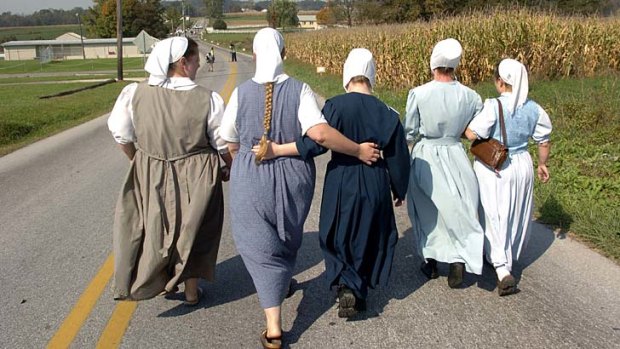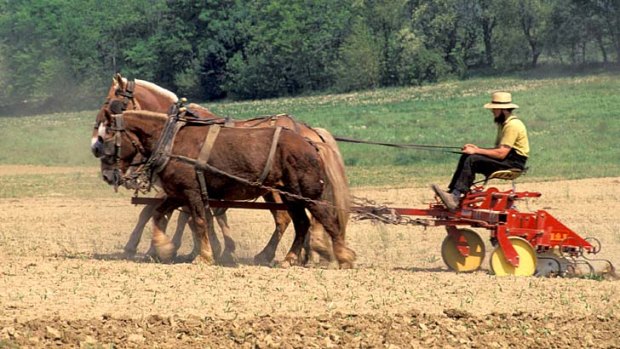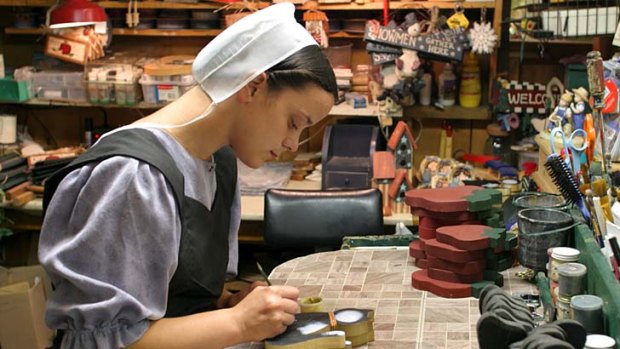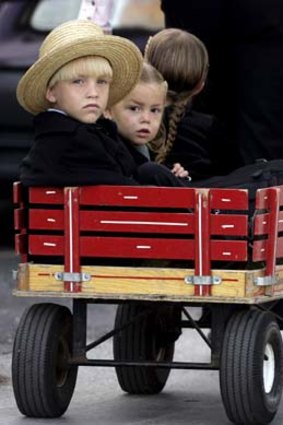
The simple life ... Amish women walk along the quiet road.Credit: Getty Images
Exploring Pennsylvania Dutch Country is like stepping back in time but, as Barbara Noe reports, the slower, technology-free life has its compensations.
I am too close to my iPhone. Every question I have, whether it's a trivial fact, directions to a restaurant or a news update, I find myself unconsciously reaching for this clever little device, to the point where I'm not sure my brain is thinking on its own any more.
I clearly have a problem, so I'm escaping to Pennsylvania Dutch Country, where the Amish seem to do fine without modern technology. I'm taking my 12-year-old niece and two nephews, aged 10 and 14, and I'm curious to see their reaction to these religious people devoted to a simple life of farming without electricity, cars, tractors or telephones - and certainly no iPhones.

An Amish farmer in a horse-drawn plough.Credit: Getty Images
We enter Amish country on busy Route 30, about 120 kilometres west of Philadelphia near Lancaster, a bit disappointed as we scan the strip malls and traffic for any sign of bygone days. Frankly, at first glance the Lancaster area is rather ugly, with every hotel and fast-food chain beckoning with gaudy neon lights.
Just as I'm thinking we must have taken a wrong turn, I see amid all the cars a little black buggy being pulled by a beautiful chestnut horse. I try to be discreet but can't help myself from peering inside, where I see a man with a black rimmed hat and a long grey beard but no moustache and a woman with her hair tucked severely back in a black bonnet, like a scene from a Dickens novel.
The best place for insight into the Amish way of life is the Amish Farm and House. Once a working Old Order Amish farm, the 1805 farmhouse is now a museum, with barns, other historic buildings and farm animals scattered over six hectares. Where a group would once have gathered for church services, we sit on hard wooden benches in the front room of the house for a historical overview of the Amish.

An Amish girl at work at the Bird in Hand Farmers Market.Credit: Alamy
Jakob Ammann founded the Amish sect in 1693 in Europe, we learn, in response to the belief that the Mennonite faith he followed lacked sufficient discipline. Members of the group began arriving in Pennsylvania in 1700, where William Penn promoted the spirit of religious tolerance.
The house tour is fascinating, with the guide pointing out various Amish touches, such as the fact that pictures and photos aren't hung on the walls. Perhaps the most interesting rooms are the bedrooms, with colourful quilts, simple wood furniture and hand-sewn clothes hanging from pegs on the wall; the same dress is worn for church, weddings and funerals, so there's not much need for a wardrobe.
The guide points out that the women's dresses are held together with straight pins - buttons are considered ornamentation, so it would be vain to wear them. A pair of rollerblades hanging in the boys' room, looking incongruously modern in the traditional setting, is an acceptable mode of transportation for errands and going to school, the guide tells us.

Amish children in a wagon.Credit: AFP
I had planned our visit to coincide with market day in the crossroads village of Bird-in-Hand, where the Amish sell their produce and wares at the market. Since the Amish originated in German-speaking Switzerland, much of the fare - as well as their accents - has a German flavour (they speak a German dialect called Pennsylvania Dutch).
We start by sampling fresh apple cider, then make our way around the stalls, admiring sticky buns, apple dumplings, packages of snitz (dried apples), chow-chow (sweet pickled vegetable mix), shoo-fly pie (made basically of molasses and brown sugar), whoopie pie (cream-filled chocolate cake in a burger-shaped sandwich) and other Pennsylvania Dutch treats. Some stalls purvey beautiful quilts, bonnets and dolls in Amish garb with no faces (the Amish believe it is against the scripture to create graven images, even on dolls).
Later, we climb aboard a buggy for a horse-drawn spin along bucolic lanes in countryside speckled with churches, barns, tobacco farms and signs advertising quiltmakers and eggs for sale. Clip-clopping along, we can pick out the Amish houses: laundry hangs on lines in sombre violet, black and sage; farmers plough their fields with giant shire horses; no electricity cables connect the houses to the grid because the Amish don't believe in electricity for fear it could lead to temptation and the deterioration of church and life.
Our guide, a young Amish girl, is chatty and quite open about her Amish way of life. Ten-year-old Charlie, who sits up front with her, wants to know why the Amish don't drive cars. "We use buggies to slow our speed of life," she replies. Charlie nods. He next wants to know what the children do when it rains. "We play Monopoly and other board games," she replies. "What do you do at night?" he asks, after a lull. She says they read together and play games, but there's not much time in the evening because children must do chores. And then after dinner, homework must be done. And since they must get up early to do more chores, they go to bed early.
They're discussing two very diverse worlds, the archaically dressed Amish girl and my nephew in his baseball cap. But even with all the differences, one thing is clear: the underlying elements of our lives - family, friends, school, chores - aren't too different.
That gives me the courage to think that perhaps I can wean myself ever so slightly from my iPhone. But for now, I click it back on to see which one of these bucolic lanes will lead me back to the "outside world".
Telegraph, London
Top tips
1 Don't show up at an Amish-run business on Sunday. It will be closed. And don't expect to pay with a credit card or cheque.
2 Don't take pictures. Most Amish consider photographs an act of pride and it's against the scriptural admonition to make graven images of themselves.
3 Don't hesitate to ask an Amish shopkeeper questions about their way of life. Many are happy to answer questions.
Trip notes
Getting there
Qantas flies from Sydney direct to Dallas-Fort Worth, with connections to Philadelphia. qantas.com.au. It's best to rent a car and drive to Amish country, 100 kilometres west of Philadelphia. Or you can take the train (Amtrak; +1 1800 872 7245; amtrak.com) to Lancaster and rent a car from there.
Staying there
Clarion Inn Historic Strasburg Inn has basic rooms and a peaceful farm setting near Amish sites. 1400 Historic Drive, Strasburg. Doubles from $US65 ($62). +1 717 687 7691, clarioninnstrasburg.com.
Beacon Hollow Farm Amish Guest House is a charming two-bedroom guesthouse on an Amish dairy farm. 130 Centerville Road, Gordonville. From $US80. +1 717 768 8218, afarmstay.com.
Cork Factory Hotel is a boutique hotel at Lancaster, with 77 slick, modern rooms featuring brick walls and vaulted wooden ceilings that hark back to its heyday as a cork factory. 480 New Holland Avenue, Lancaster. Doubles from $US139. +1 717 735 2075, corkfactoryhotel.com.
Touring there
The Amish Farm and House offers a 90-minute farmland tour that departs from the Pennsylvania Dutch Country Visitor Centre four times a day between late May and October. 501 Greenfield Road, Lancaster. $US21 for adults, $US10.95 for children five to 11, $US4.95 for children under five. +1 1800 723 8824, padutchcountry.com.
You can also hire a guide through the Mennonite Information Centre to travel with you in your car and show you the area, including driving through one of the region's 30 covered bridges and stopping at a few Amish-owned businesses. 2209 Millstream Road, Lancaster. Closed on Sundays. From $US49 a vehicle for a two-hour tour. +1 717 299 0954, mennoniteinfoctr.com.
You can rent a bike and pedal the quiet country back roads of Amish country. Check out the Lancaster Bicycle Club's website for scenic route options — you can join a group or follow the itinerary on your own. Rent bikes at Era Pro Road Bike Shop, 830 Flory Mill Road, Lancaster. $US40, closed on Sundays. +1 717 560 9000, erapro.com.
Shopping there
The Amish are celebrated for their gorgeous quilts, as well as one-of-a-kind crafts, hand-built furniture and folk art. Look for them in local stores, farmers' markets and quilt shops. Items are also often advertised on handwritten signs in front of farmhouses on the area's back roads. Farmers' markets are the perfect spot to find home-made jams and relishes. The Pennsylvania Dutch Convention and Visitors Bureau website offers a shopping itinerary.
Eating there
Be sure to try a family-style, all-you-can-eat dinner at one of the region's famous Amish restaurants, featuring roast beef, baked ham, fried chicken, buttered noodles, mashed potatoes, chicken pot pie and home-made bread. Good 'N Plenty Restaurant (150 East Brook Road, Smoketown; +1 717 394 7111, goodnplenty.com), Miller's Smorgasbord (2811 Lincoln Highway East, Ronks; +1 1800 669 3568, millers1929.com) and the Plain & Fancy Farm Restaurant (3121 Old Philadelphia Pike, Bird-in-Hand; +1 1800 669 3568, plainandfancyfarm.com).
When to go
Between mid-summer and September is a great time to explore the back roads and take advantage of roadside stalls that sell freshly harvested produce, jams and home-made baked goods. Mud sales — Amish and Mennonite auctions where everything from horses and tractors to quilts and family heirlooms are sold — are held in spring. The largest is at Gordonville.
Sign up for the Traveller Deals newsletter
Get exclusive travel deals delivered straight to your inbox. Sign up now.